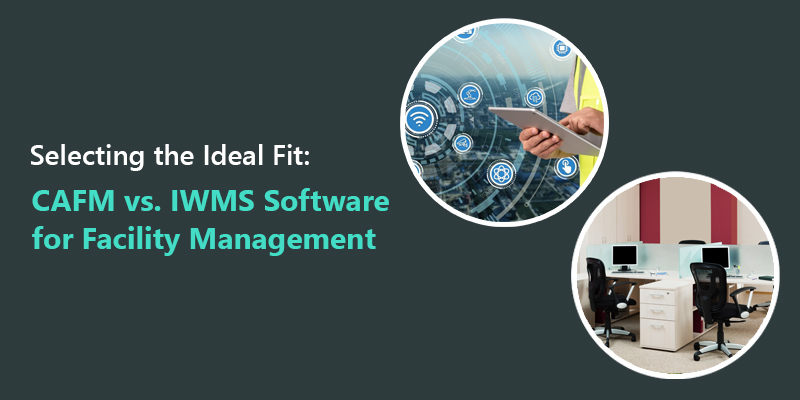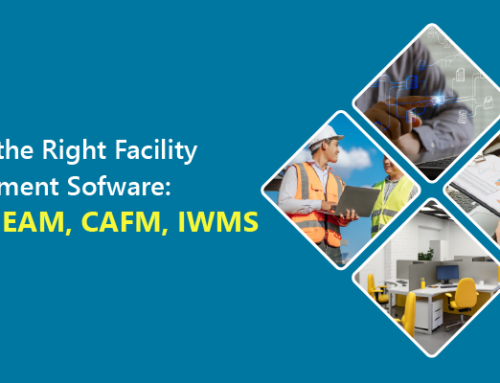In today’s dynamic business environment, efficient facility management software is crucial for organizations aiming to maintain seamless operations, optimize resource utilization, and enhance productivity. This has spurred the development of technology tools like between Computer Aided Facilities Management Software (CAFM) and Integrated Workplace Management System (IWMS) each offering unique functionalities to support effective facility management.
CAFM Software focuses on administrative tasks such as space management, resource allocation, maintenance, and operations oversight. In contrast, IWMS Software provides a deployable solution by integrating various workplace management functions like real estate management, facility maintenance, capital project management, and sustainability initiatives into a unified system.
Understanding CAFM Software
CAFM Software, or Computer-Aided Facility Management Software, is a crucial tool utilized by facility managers and their teams to streamline the oversight and improvement of facility operations. This solution excels in integrating and analyzing data related to physical spaces, assets, equipment, and personnel, offering a comprehensive view of facility management processes. It plays a pivotal role in various management functions, including space and occupancy management, move coordination, asset tracking, and maintenance management.
One of the primary strengths of CAFM software lies in its ability to provide a holistic perspective on facility operations, enabling informed decision-making processes. It is particularly adept at managing and optimizing the tangible elements of facilities, such as space utilization and asset maintenance. Key functionalities of CAFM systems include preventive maintenance scheduling, efficient work order management, and generating insightful basic reports.
By leveraging CAFM Software, facilities can achieve several benefits, including optimal operational efficiency, enhanced asset utilization, and improved overall facility performance. Additionally, CAFM software offers real-time information and comprehensive databases, enhancing efficiency, reducing operating costs, aiding in decision-making, and ensuring regulatory compliance. It is widely used across various industries such as manufacturing, healthcare, retail, education, and government sectors to drive efficiencies and optimize facility management processes.
Exploring IWMS Software
Integrated Workplace Management Software (IWMS) represents a sophisticated approach to addressing the complex demands of modern workplaces. It has evolved from earlier systems like CMMS, EAM, and CAFM, incorporating and expanding upon their functionalities. Unlike its predecessors, IWMS is designed specifically to integrate real estate, facility, and workplace management functions into a centralized platform.
This centralized approach offers numerous benefits, including increased efficiency, cost savings, improved productivity, and enhanced data accuracy. By leveraging cloud-based technology, IWMS enables real-time tracking and monitoring, making it particularly beneficial for organizations with large real estate portfolios, multiple facilities, or intricate space management requirements.
One of the key distinctions of IWMS is its heightened focus on workplace management. While CAFM covers a broader spectrum of infrastructure, IWMS prioritizes optimizing buildings and workplaces. It emphasizes efficient space utilization, employee well-being, and overall workplace productivity. In essence, IWMS serves as a pinnacle solution, providing nuanced tools to address the evolving demands of contemporary workplaces with precision and sophistication.
Comparing CAFM and IWMS Software
Both CAFM and IWMS software streamline facility management tasks by centralizing data collection and management functions, including space management, maintenance, and asset tracking. However, CAFM excels at administrative tasks like maintenance scheduling, whereas IWMS offers a broader, deployable solution integrating multiple functions related to real estate, facilities, and workplace management.
Choosing Between CAFM and IWMS Software
The choice depends on an organization’s needs. CAFM may suit businesses requiring focused facility management, while IWMS is better for companies needing comprehensive integration and strategic decision-making tools. IWMS may be preferred by large corporations with extensive facilities and data management needs, whereas CAFM is suitable for smaller organizations or simpler facility management needs.
Read also: https://www.efacility.in/difference-between-cmms-eam-cafm-iwms-software/
Conclusion
In conclusion, CAFM and IWMS software offer unique advantages tailored to different business needs and industry types. CAFM enhances operational efficiency through administrative utility and management capabilities, while IWMS provides a comprehensive package for integrated facility management operations. The primary difference lies in usability, with CAFM focusing on administrative management and IWMS offering an all-inclusive deployable system.
Read also: https://www.efacility.in/7-reasons-to-switch-to-efacility-cafm-iwms/
Frequently Asked Questions (FAQs)
1. Is CAFM Software better than IWMS software?
The choice between CAFM and IWMS software depends largely on a business’s specific needs. CAFM is more administratively oriented, while IWMS provides a more comprehensive all-around solution.
2. Can IWMS Software be used for small businesses?
Absolutely. IWMS software is scalable, making it suitable for businesses of all sizes. Its functionalities can be tailored to meet the needs of small businesses.
3. Is it necessary to have separate CAFM and IWMS Software or can one software perform both functions?
Most IWMS solutions incorporate functionalities commonly found in CAFM software. Therefore, a comprehensive IWMS software could potentially cater to both requirements.
4. How do CAFM and IWMS Software aid in cost reduction?
Both CAFM and IWMS software allow businesses to better organize, manage, and streamline their resources. This leads to more efficient operations and, eventually, cost reductions.
5. Can you transition from CAFM Software to IWMS Software?
Yes, it is possible to transition from a standalone CAFM to an integrated IWMS. It would, however, require technical expertise to ensure data migration and systems integration are carried out effectively.













